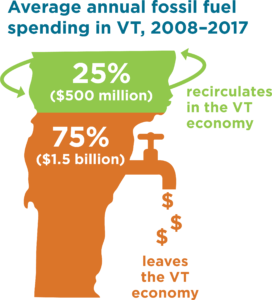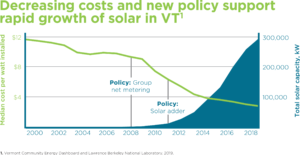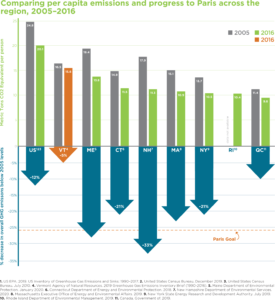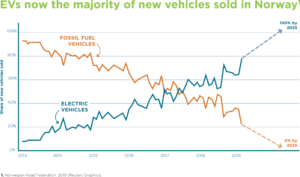You can view video of the press conference here.
 Remarks as Prepared for Delivery
Remarks as Prepared for Delivery
March 11, 2020
Press Conference on the Release of EAN’s 2019 Annual Progress Report for Vermont
Cedar Creek Room, Vermont State House
Good morning and thank you for joining us. My name is Jared Duval, Executive Director of the Energy Action Network.
It is a great pleasure to share with the legislature, the administration, our Network members, and the media EAN’s latest Annual Progress Report for Vermont, with a focus on energy, emissions, the economy, and equity.
***
First let me say a word about EAN. Our Network is made up of a diversity of businesses, non-profits, utilities, colleges and universities, and public partners – over 200 in total. The mission of the Network is to achieve Vermont’s Comprehensive Energy Plan goals, including a 90% renewable by 2050 total energy commitment, and to significantly reduce greenhouse gas emissions in ways that create a more just, thriving, and sustainable future for Vermonters.
To serve and support this Network, a small non-profit organization exists to serve a couple of key roles:
- One, we serve as a neutral convener of our diverse Network. To respect the many opinions across the Network, EAN the non-profit does not lobby for particular bills.
- Two, we work with public partners from the local to the state to the federal level to collect data and track progress toward Vermont’s energy and climate commitments, conduct analysis about the challenges and opportunities of meeting them, and to share independent and objective information and analysis — primarily through this Annual Progress Report. Our aim is to both ground and advance Vermont’s energy and climate conversation with data and evidence.
This report is a major undertaking that is only possible thanks to the good work and close collaboration of Network members and public partners. So, before I review the highlights of the report, I want to begin with some thank yous:
- First, to Carolyn Wesley, EAN’s Network Manager, who managed the production of the report from start to finish
- Pamela Hathaway, EAN’s Energy Research Analyst
- Leigh Seddon, EAN’s President and one of our Senior Fellows, who led much of the energy analysis
- Our public partners including the Public Service Department (Deputy Commissioner Riley Allen, Ed McNamara, TJ Poore, Anne Margolis, Maria Fischer, Philip Picotte, and Andrew Perchlik); the Agency of Natural Resources (especially Department of Environmental Conservation Commissioner Peter Walke—who you will hear from shortly—, Collin Smythe, who leads Vermont’s greenhouse gas inventory, and Paul Frederick and Emma Hanson from the Department of Forests, Parks, and Recreation); the Agency of Commerce & Community Development (especially Economic Research Analyst Ken Jones); and VTrans (especially Dan Dutcher).
- Thanks also to the team at VEIC (including Efficiency Vermont Director Rebecca Foster—who you will hear from shortly—Kelly Lucci, Perri Kimball, Dave Roberts of Drive Electric Vermont, and Adam Sherman of the Biomass Energy Resource Center)
- And thanks to the Transportation Research Center at UVM (Jonathan Dowds).
With that, without further delay, let me provide a summary of the findings in this year’s report:
***
First and most importantly: the transition off fossil fuels is an economic development and affordability strategy for Vermont. This topic is particularly important to me because, before I led EAN, I served as Economic Development Director at the Agency of Commerce and Community Development.
The economic conversation about energy has for too long been backwards. Often the question will be asked, “how much will it cost us” to move from fossil fuel to efficient, renewable energy use. This report shows that there are three key questions that we should be asking instead:
1) how much is our fossil fuel dependence currently costing Vermonters and the Vermont economy?
2) how much do Vermonters stand to save on energy costs as a result of this transition?; and
3) how will the Vermont economy be affected by a transition off fossil fuels?
To answer these questions, the Vermont Agency of Commerce and Community Development conducted an economic impact analysis of EAN’s “Path to Paris” model. The Path to Paris model takes proven and available technologies and best practices as outlined in Vermont’s Comprehensive Energy Plan and models the scale and pace of efficient and renewable energy adoption, primarily for how we get around and heat our homes and buildings, that will be necessary to meet Vermont’s commitment to the Paris Climate Agreement.
What ACCD found is that if we meet our Paris commitment in this way, it is estimated that we will keep more money in state and Vermonters will keep more money in their pockets. Specifically, ACCD estimates that we can reduce the net amount of dollars draining out of the Vermont economy by over $1.1 billion, increase net investment in in-state businesses by over $300 million, and save Vermont consumers nearly $800 million between 2020 and 2035.
This analysis, by ACCD’s own admission, is very conservative. For instance, it does not include the value of state incentives in the consumer savings calculations, which can result in significant additional savings for Vermonters who do weatherization projects or install renewable heating systems like advanced wood heating or cold climate heat pumps. It also projects electric vehicle prices to stay at their current levels for the next five years, when we know that battery and EV prices are declining every year. It also projects fossil fuel prices to stay at their current, historically low levels, when we’ve seen that they have been quite volatile over time. Furthermore, it does not account for other price decreases for clean technologies due to increasing economies of scale or further technological improvements. Finally, and perhaps most importantly, it doesn’t account for the very real costs of climate disruption, or what some refer to as the “social cost of carbon.”
Let me state those numbers again: reducing the flow of dollars out of state by over $1.1 billion dollars, increasing investment in Vermont-based businesses by over $300 million, and achieving net consumer savings for Vermonters of nearly $800 million. The reasons for this very good economic news lie in two key differences between fossil fuels vs. more efficient, renewable energy alternatives.
First, Vermont averages about $2 billion a year in fossil fuel spending, three quarters of which, or $1.5 billion, drains right out of our state economy. That’s only 25 cents of every dollar spent on fossil fuel staying in the Vermont economy. All of the efficient and renewable alternatives keep much more of our energy dollars local: 60 cents of every dollar invested in weatherization, 62 cents of every dollar spent on electricity, and 80 cents of every dollar spent on wood stay local, support jobs for our neighbors, and strengthen the Vermont economy. We understand the benefits of “buy local” in our agriculture and food sector. The same is true when it comes to energy.
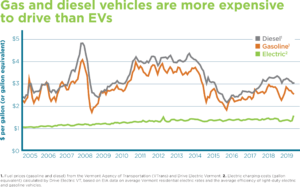
Second, fossil fuels are more expensive and have more volatile prices than electricity and renewable fuels. The lowest cost way to get around or to heat your home or building with the most stable and predictable prices is with electricity or wood heat.
We have proven, available, and cost-effective solutions to reduce climate pollution and save Vermonters money from transportation and heating. No matter where you live in Vermont and no matter what type of home or building you’re trying to heat, there is an efficient and renewably sourced heating technology that can work right now. And there are about three dozen electric vehicle models currently available in Vermont, including ten all-wheel drive options, soon to include pick-up trucks.
Specifically, for a Vermonter who buys or leases a new electric vehicle instead of a new fossil fuel vehicle, who installs a multi-head cold climate heat hump system to displace three quarters of their fossil fuel use, and who installs a heat pump water heater to replace an old electric water heater, ACCD projects the savings over ten years to be nearly $10,000 combined from those three actions.
Of course, individual savings will vary based on investments made and actions taken, but there is the potential for these savings to be significant, especially as prices of clean technologies continue to decline and when utility and state incentives are added to these totals. Of course, not everyone can afford the up-front investment of a new vehicle or heating system, and that’s where additional state policy and incentives will have to come in if we are to have an equitable energy transition.
While solar, wind, and hydro electricity generation technology have been around for decades, the solutions for how we get around and heat our homes and buildings efficiently without fossil fuels are newer. A big part of this transition will be making sure Vermonters are aware of cleaner, healthier, and more economical ways to get around and heat their homes and buildings. A decade ago there were fewer than 100 electric vehicles in Vermont and no cold climate heat pumps. As of last year, there are over 3,500 EVs registered in Vermont, over 17,000 heat pump systems, and over 11,000 heat pump water heaters. Those numbers are growing every year and could be the beginnings of a wholesale market transformation, similar to when cell phones replaced landlines and to the growth of solar PV… if we put policies in place to support their adoption and send the right market signals.
***
This report also includes a comparison of greenhouse gas emissions from every state in New England plus New York and our neighbor to the north, Quebec. What we found is that:
- Vermont is the only state in the region that has failed to reduce its emissions below 1990 levels.
- Vermont has made the least progress toward the Paris Climate Agreement commitment of any state in the region.
- And Vermont has the highest emissions, per capita, of any state in the region at over 15 tons of greenhouse gases per person.
Why is this happening?
One big reason is the increase in our transportation emissions since 1990. There are more vehicle miles traveled in Vermont than any state in the region, and miles driven have been rising since 2014. Additionally, we are not getting the full benefit of increased fuel economy standards because Vermonters who buy or lease new vehicles are opting for bigger and bigger vehicles. In 2012, 55% of new vehicles purchased in Vermont were SUV’s or pickup trucks. In 2018, that number was 80%.
As of 2016, Vermont’s emissions from electricity were 8% of our total statewide emissions, while emissions from transportation and thermal energy use made up more than 70% of our emissions. The 2018 data shows that emissions from electricity have continued to decline, and are now only 2% of Vermont’s total greenhouse gas emissions.
And yes, while we have achieved real and important emissions reductions from our electricity sector (and can still make more), they have been dwarfed by increased fossil fuel use for how we get around and heat our homes and buildings.
While we can do more, the progress we have already made in our electricity sector is impressive and represents a strong foundation for further progress. Thanks to the Renewable Energy Standard, passed in 2015, Vermont has cut its emissions from electricity over 80% between 2015 and 2018. This will get us about one quarter of the way toward our Paris Climate Agreement commitment.
As a result of the Renewable Energy Standard, Vermont now has the lowest emitting electricity sector in the entire country, both overall and per capita. What having the cleanest electricity in the US means is that whenever we electrify how we heat our homes, with heat pump water heaters or cold climate heat pumps, or how we get around with electric vehicles, we get a greater emissions reduction benefit from doing so than anywhere else in the United States.
***
While EAN’s Path to Paris may sound like a big lift, looked at another way it’s not asking very much: all we have to do to meet this commitment is get our per capita emissions down to those of New Hampshire over the next 5 years. That means each Vermonter, on average, reducing our climate pollution by 4 tons per year.
It’s really quite simple: fossil fuels are the problem and each of us has to do what we can to stop creating new demand for them, especially because electric and renewable alternatives are proven, ready, and available. Most Vermonters I know don’t like using gasoline or diesel or fuel oil or propane. They simply do so because that’s what the vehicles they use to get around run on, or because that’s what their heating system requires. To reduce fossil fuel use, part of the solution is helping make sure that we transition out the equipment – the vehicles and heating systems – that lead to fossil fuel use in the first place, by focusing on the point of purchase. Once those vehicles, heating systems, and pieces of equipment are ready to be replaced, we can avoid decades of further fossil fuel pollution and cost.
If you are a Vermonter concerned about the climate, doing your part, and not being exposed to the relatively high and volatile prices of fossil fuels, here’s a commitment you can make to help do that: never buy a new fossil fueled vehicle again; never install a new fossil fueled heating system again; never purchase anything that uses fossil fuel again. Most Vermonters just don’t need to, given the proliferation of electric and renewable alternatives, for everything from vehicles to efficient heating to lawn care. Vermont simply cannot afford new vehicles, new heating systems, and other fossil fueled equipment that will lock in continued fossil fuel use for decades. And Vermonters can’t afford high and volatile prices of those fuels, or of being stuck owning stranded assets.
For those Vermonters with fewer means, it is the responsibility of our government to ensure a progressive and equitable transition with incentives to help, so that the economic gains—that $800 million in consumer savings I mentioned earlier–don’t just go to well-off Vermonters, leaving many other Vermonters exposed to high and volatile fossil fuel prices. This transition is not a sacrifice, it is an opportunity with great economic benefit, for both individual Vermonters and the state economy. The efficient and renewable alternatives, from electric vehicles to cold climate heat pumps and advanced wood heating systems are cleaner, have lower lifetime costs, and do far more to keep dollars local and grow the Vermont economy.
***
This year we have also included policy case studies from across the world of places that have been the most successful at reducing emissions while improving their economy. Norway stands out for driving down emissions from their transportation sector. They have done so by:
- Passing a law requiring that all passenger vehicles sold after 2025 be zero emissions
- Putting a fee on the purchase of new fossil fueled vehicles between now and 2025, to account for the social and environmental cost of the pollution they create.
- Using that revenue to provide incentives for EV purchases.
- Together, these policies have already led to the majority of new vehicle sales in Norway being electric as of 2018.
The approach of setting a future date certain past which old and dangerous technologies that are hazardous to human health and the environment will be banned, as Norway has done with their phase out of fossil fueled vehicles by 2025, is not new. The United States has taken a similar approach to substances like lead and asbestos. The difference is that fossil fueled vehicles, heating systems, and other pieces of equipment are not just detrimental to human health — they are destabilizing the entire climate on which we depend.
In summary, we have the technology to move toward ending fossil fuel use and to do so in a way that brings economic benefit to all Vermonters. But this transformation will not happen without a comprehensive energy policy and regulatory framework that also requires emissions reduction from the transportation and thermal sectors – where over 70% of Vermont’s climate pollution comes from. And this transition will not be equitable without state incentives and assistance to ensure that the economic savings and health benefits of getting off fossil fuels don’t just accrue to upper income Vermonters. As Upper Austria, Norway, Quebec, California, and every other country, province, and state we have studied has learned: pairing emissions reduction with economic growth requires both sticks and carrots, or regulations and incentives — and it requires doing so across all energy sectors, not just electricity.
In addition to the new analysis and findings I have summarized, the report also includes the official tracking information that our network members, public partners, and the media have come to expect from EAN reports. You will find all of this in both the printed reports, which are available for you here today, and on EAN’s website: eanvt.org.


